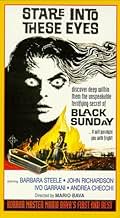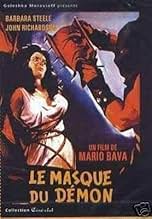IMDb-BEWERTUNG
7,1/10
18.494
IHRE BEWERTUNG
Eine Hexe und ihr Diener kehren aus dem Grab zurück und beginnen einen blutigen Feldzug, um den Leichnam des wunderschönen, ihr ähnlich sehenden Nachkommen der Hexe in Besitz zu nehmen.Eine Hexe und ihr Diener kehren aus dem Grab zurück und beginnen einen blutigen Feldzug, um den Leichnam des wunderschönen, ihr ähnlich sehenden Nachkommen der Hexe in Besitz zu nehmen.Eine Hexe und ihr Diener kehren aus dem Grab zurück und beginnen einen blutigen Feldzug, um den Leichnam des wunderschönen, ihr ähnlich sehenden Nachkommen der Hexe in Besitz zu nehmen.
- Auszeichnungen
- 1 Gewinn & 1 Nominierung insgesamt
Barbara Steele
- Princess Asa Vajda
- (as Barbara Steel)
- …
Giuseppe Addobbati
- Priest
- (Nicht genannt)
Fernando Cajati
- Crucifixion Torturer
- (Nicht genannt)
Valentina Cortese
- Tavern Girl
- (Nicht genannt)
Angelo Galassi
- Tavern Keeper
- (Nicht genannt)
Nando Gazzolo
- Narrator
- (Synchronisation)
- (Nicht genannt)
Renato Montalbano
- Spectator
- (Nicht genannt)
Handlung
WUSSTEST DU SCHON:
- WissenswertesMario Bava and Barbara Steele had a difficult working relationship. She sometimes refused to come to set because she did not like her wig or the fact that her cleavage would be shown. One time she refused because she believed Bava would force her to appear nude. She admits that she was difficult due to her inexperience and inability to understand Italian.
- PatzerIn the opening credits, Barbara Steele's name is misspelled as Barbara Steel.
- Zitate
Princess Asa Vajda: You, too, can feel the joy and happiness of hating.
- Crazy CreditsFor "The Mask of Satan," the English language version prepared in Italy, Barbara Steele's name is listed as "Barbara Steel" on the trailer and on the credits of the film itself.
- Alternative VersionenThe full list of differences between the 83-minute original cut and the 80-minute AIP cut:
- A different English-language dub, and a new score by Les Baxter.
- An added pre-text crawl warning the audience about the film's content: "The producers of the picture you are about to see feel a moral obligation to warn you that it will shock you as no other film ever has. Because it could be very harmful to young and impressionable minds, it is restricted to only those over fourteen years of age."
- Alternate opening credits.
- A brief exchange between Katja and Constantine where he tells her their father has died is cut.
- A scene where Katja and Andrej talk in the garden is cut.
- An exchange between Katja and Andrej outside her room is cut.
- Kruvajan's death scene is cut down significantly to remove shots of his eye spurting blood.
- The scene were Prince Vajda reanimates and menaces Katja is trimmed.
- Vajda's death scene, particularly the close-ups of his head melting, is trimmed.
- Asa taunting Andrej before being burned at the stake is cut.
- Added closing credits.
- VerbindungenFeatured in I motorizzati (1962)
Ausgewählte Rezension
Be sure and watch the uncut version with the title "The Mask of Satan," not the censored "Black Sunday" copy, to get the full effect of this living dead masterpiece of Italian cinema. More a movie of the undead than a vampire flick, it reminds the horror aficionado of a Val Lewton film from the 1940's, especially "The Leopard Man," not that "The Mask of Satan" is about leopards, but the mood and atmosphere are similar.
The film is about a woman of darkness and her mate who were executed for witchcraft two centuries before the Napoleonic period of European history. The most gruesome feature of the execution involved nailing a mask of Satan to their faces by means of a giant sledgehammer before they were entombed. By accident two hundred years later a doctor and his assistant while journeying through the region by coach on a dark stormy night filled with eerie devilish sounds, the doctor removes the mask from Princess Asa Vajda supposed corpse. Now Princess Vajda and her fiendish companion become free to seek their revenge. Their evil is released on the world and must be stopped.
This is undoubtedly director Mario Bava best film. The marvelous camera work draws the viewer into the maelstrom of darkness and evil through innovative movements and angles. The shadowy settings where the actors are posed in ominous fashion are unforgettable. One obvious inspiration for Bava was the contemporary British Hammer horror film popular in America, especially with the drive-in crowd. The arrival of Katia Vajda with what appear to be the dogs of Hell, standing like a silhouette of damnation, reminds one of a Caspar David Friedrich painting from the German Romantic art movement of the Napoleonic era. One wonders if the director of "The Omen," Richard Donner, patterned his creepy scene in the cemetery with the Rottweilers after this scene in "The Mask of Satan."
This movie remains a must see for horror fans, somewhat of a lost treasure.
The film is about a woman of darkness and her mate who were executed for witchcraft two centuries before the Napoleonic period of European history. The most gruesome feature of the execution involved nailing a mask of Satan to their faces by means of a giant sledgehammer before they were entombed. By accident two hundred years later a doctor and his assistant while journeying through the region by coach on a dark stormy night filled with eerie devilish sounds, the doctor removes the mask from Princess Asa Vajda supposed corpse. Now Princess Vajda and her fiendish companion become free to seek their revenge. Their evil is released on the world and must be stopped.
This is undoubtedly director Mario Bava best film. The marvelous camera work draws the viewer into the maelstrom of darkness and evil through innovative movements and angles. The shadowy settings where the actors are posed in ominous fashion are unforgettable. One obvious inspiration for Bava was the contemporary British Hammer horror film popular in America, especially with the drive-in crowd. The arrival of Katia Vajda with what appear to be the dogs of Hell, standing like a silhouette of damnation, reminds one of a Caspar David Friedrich painting from the German Romantic art movement of the Napoleonic era. One wonders if the director of "The Omen," Richard Donner, patterned his creepy scene in the cemetery with the Rottweilers after this scene in "The Mask of Satan."
This movie remains a must see for horror fans, somewhat of a lost treasure.
Top-Auswahl
Melde dich zum Bewerten an und greife auf die Watchlist für personalisierte Empfehlungen zu.
Details
- Laufzeit1 Stunde 27 Minuten
- Farbe
- Sound-Mix
- Seitenverhältnis
- 1.66 : 1
Zu dieser Seite beitragen
Bearbeitung vorschlagen oder fehlenden Inhalt hinzufügen

Oberste Lücke
By what name was Die Stunde, wenn Dracula kommt (1960) officially released in India in English?
Antwort































